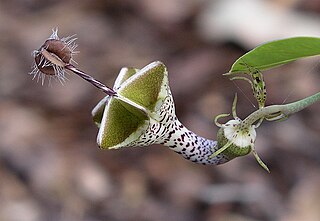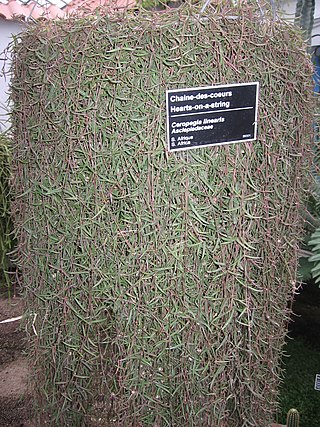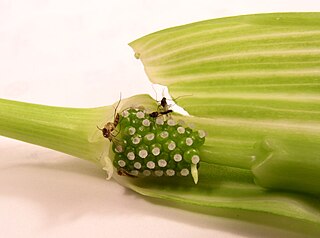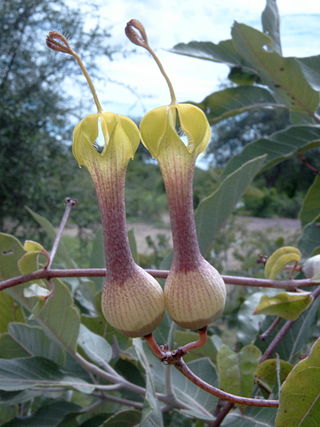
A vine is any plant with a growth habit of trailing or scandent stems, lianas or runners. The word vine can also refer to such stems or runners themselves, for instance, when used in wicker work.

Toxicodendron radicans, commonly known as eastern poison ivy or poison ivy, is an allergenic Asian and Eastern North American flowering plant in the genus Toxicodendron. The species is well known for causing urushiol-induced contact dermatitis, an itchy, irritating, and sometimes painful rash, in most people who touch it. The rash is caused by urushiol, a clear liquid compound in the plant's sap. The species is variable in its appearance and habit, and despite its common name, it is not a true ivy (Hedera), but rather a member of the cashew and pistachio family (Anacardiaceae). T. radicans is commonly eaten by many animals and the seeds are consumed by birds, but poison ivy is most often thought of as an unwelcome weed. It is a different species from western poison ivy, T. rydbergii, which has similar effects.

Campsis radicans, the trumpet vine, yellow trumpet vine, or trumpet creeper, is a species of flowering plant in the family Bignoniaceae, native to eastern North America, and naturalized elsewhere. Growing to 10 metres, it is a vigorous, deciduous woody vine, notable for its showy trumpet-shaped flowers. It inhabits woodlands and riverbanks, and is also a popular garden plant.

Ceropegia is a genus of plants within the family Apocynaceae, native to Africa, southern Asia, and Australia. It was named by Carl Linnaeus, who first described this genus in his Genera plantarum, which appeared in 1737. Linnaeus referred to the description and picture of a plant in the Horti Malabarici as the plant for which the genus was created. In 1753 he named this species as Ceropegia candelabrum. Linnaeus did not explain the etymology but later explanations stated that the name Ceropegia was from the Greek word keropegion κηροπηγɩον. This means candelabrum in Latin, which has a broader range than the modern word - "a candlestick, a branched candlestick, a chandelier, candelabrum, or also lamp-stand, light-stand, sometimes of exquisite workmanship".
Murlen National Park is a national park located in the Champhai district Mizoram in India. The size of the park area is 200 km2 (77 sq mi). The park is situated about 245 km east of Aizawl, and is close to the Chin Hills. It lies north of Lengteng Wildlife Sanctuary in the same district. It covers an area of approximately 100 km2. The tropical, semi-evergreen and sub montane Forests of Murlen are home to a rich variety of flora and fauna. About 15 species of mammals, 150 species of birds, 35 species of Medicinal plants, 2 species of bamboos, and 4 species of orchids so far have been recorded in this Park. In 2012, 36 people were involved in conservation work of Murlen National Park.

Ceropegia woodii is a flowering plant in the dogbane family Apocynaceae, native to South Africa, Eswatini and Zimbabwe. It is sometimes treated as a subspecies of the related Ceropegia linearis, as C. linearis subsp. woodii. Common names include chain of hearts, collar of hearts, string of hearts, rosary vine, hearts-on-a-string, and sweetheart vine.
Ceropegia aridicola is a species of plant in the family Apocynaceae. It is endemic to China.
Ceropegia decidua is a species of plant in the family Apocynaceae. It is found in South Africa and Eswatini.
Ceropegia dinteri is a species of plant in the family Apocynaceae. It is endemic to Namibia. Its natural habitats are subtropical or tropical dry shrubland and rocky areas.

Ceropegia elegans is a plant species that belongs to the genus Ceropegia. It is endemic to India and Sri Lanka.

Ceropegia linearis is a species of flowering plant in the family Apocynaceae, native to Southern Africa.
Cucurbita pedatifolia is a xerophyte plant species of the genus Cucurbita. It is native to Querétaro, Mexico. It has not been domesticated. While C. pedatifolia has been cross bred, results have met with limited success. It does not cross well with other species of Cucurbita. It is a close relative of Cucurbita radicans. Geographic location and genetics make it highly likely that Cucurbita scabridifolia is a naturally occurring hybrid of Cucurbita foetidissima and C. pedatifolia. It also has some mesophyte traits may represent a transitional state between the mesophytic Cucurbita and the xerophytic Cucurbita.

Pollination traps or trap-flowers are plant flower structures that aid the trapping of insects, mainly flies, so as to enhance their effectiveness in pollination. The structures of pollination traps can include deep tubular corollas with downward pointing hairs, slippery surfaces, adhesive liquid, attractants, flower closing and other mechanisms.

Ceropegia candelabrum is the type species in its genus of plants, belonging the subfamily Asclepiadoideae. The Latin specific epithet candelabrum is derived from the candelabra-like appearance of the inflorescences.
Ceropegia huberi is a species of plant in the family Apocynaceae.
Ceropegia anjanerica is a species of flowering plant in the family Apocynaceae. Flowers are 2.5-3.5 cm long, usually slightly curved and greenish yellow in color and the plants are up to 20cm high. It is endemic to the Anjaneri Hills area of Nashik district.

Ceropegia rhynchantha is a species of plant in the family Apocynaceae. It occurs in West Africa and has slender flowers, with basal inflation and slight expansion of the tube towards the mouth, as well as relatively long, narrow lobes.

Ceropegia vincifolia is a species of flowering plant in the family Apocynaceae, native to Western Ghats, in India.

Ceropegia ampliata is a flowering plant in the dogbane family Apocynaceae, native to South Africa, Tanzania, and Madagascar. Common names include bushman's pipe, condom plant, and horny wonder.












